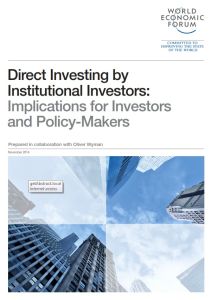Join getAbstract to access the summary!

Join getAbstract to access the summary!
World Economic Forum and Oliver Wyman
Direct Investing by Institutional Investors
Implications for Investors and Policy-Makers
World Economic Forum, 2014
What's inside?
Pension funds, insurers and other institutional investors are cutting out the middleman.
Recommendation
Some big institutional investors are buying illiquid assets on their own instead of through funds. While direct investing is nothing new, it has grown since the 2008 financial crisis, as vast stores of liquidity seek greater returns and more control. Direct investing has ramifications for investors as well as policy makers, as this World Economic Forum analysis explains. Though replete with helpful graphics, the report could use more details and examples. Nonetheless, getAbstract considers it a useful primer on trends in direct investment.
Summary
About the Authors
The World Economic Forum is an independent global organization that engages leaders of business, politics, academia and society to improve the state of the world. Oliver Wyman is a global consulting firm.






























































Comment on this summary